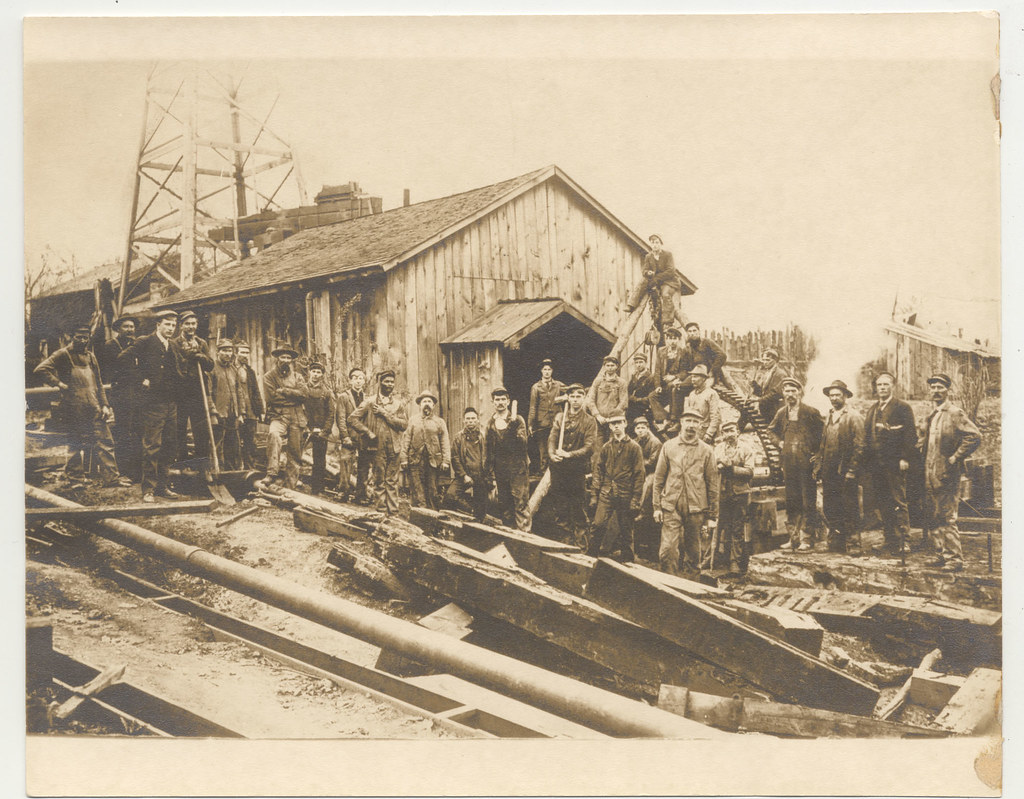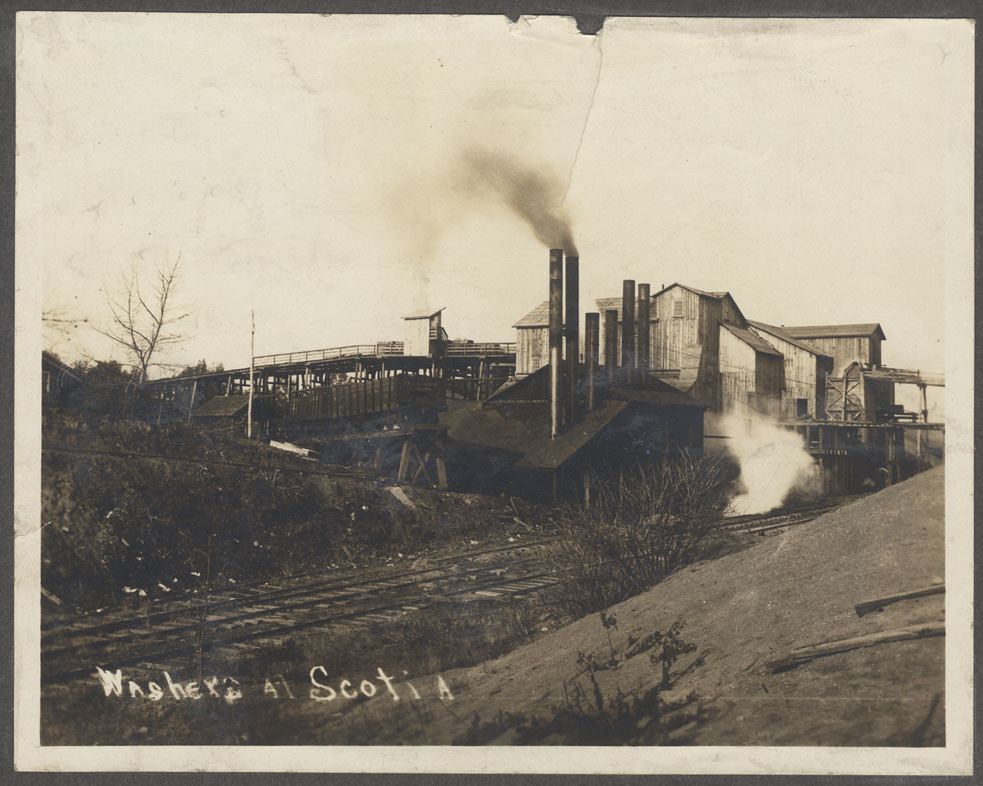Scotia was the scene of iron ore mining from the late 1700s to the 1940s, supplying ore to Centre County’s early iron furnaces and, years later, to Andrew Carnegie’s Pittsburgh steel mills.
The iron pits are part of a larger area now known as the Scotia Barrens, covering parts of Halfmoon, Patton, and Ferguson townships. The Barrens are an ecologically sensitive and rare habitat of sandy soil covered with pitch pine and scrub oak.
The Barrens were a rich source of iron ore and had been surface-mined for charcoal iron furnaces since the early nineteenth century. Scotia was the name that Carnegie gave to the production facility and village he built.
The undulating ground was not easily mined. Like much of the county’s iron deposits, the ore was embedded in sand and clay and had to be broken and washed before it could be used to make steel. Transporting the iron also was difficult.
This unique environment had been largely re-forested as many of the county’s small furnaces closed between the 1820s and 1860s. Gradually, much of the Barrens came under the ownership of Moses Thompson, the owner of Centre Furnace and the county’s largest landowner.

Around 1878, Carnegie was looking for more ore reserves for his Edgar Thompson Works near Pittsburgh. During a visit to the home of his friend George W. Lyon, at Pennsylvania Furnace, he learned of Thompson’s Barrens holdings. Carnegie’s engineers examined the ore and found its brown hematite to range in purity from 44 to 52 percent, which they concluded was better than any other they had found while searching from western Pennsylvania to Virginia.
Carnegie leased five hundred acres from Thompson and proceeded to assemble a mining operation using innovative techniques. He also persuaded the Pennsylvania Railroad to extend a line from Tyrone east to what he would call his Scotia mines. The line went up the Nittany Valley through Warrior’s Mark to Pennsylvania Furnace and on to Fairbrook and then north to Scotia.
The most significant activity began in 1880 when Carnegie acquired the River Hill Tract. Carnegie also purchased a neighboring tract to erect houses for the workers and their families. Also needed were a store, church, office building, stables, and the all-important ore washer.
The ore washer, which had been invented in 1840, separated the ore from dirt and clay. Previously, miners used picks and shovels to dig out ore found in lumps, and they bypassed the embedded ore because there was no effective way to extract it.
Another way Carnegie revolutionized the mining process was to use the newly invented steam shovel in the ore pits. In fact, he had three steam shovels in operation. Instead of loading the ore onto wagons to haul to the ore washer, he used a system of narrow-gauge railroads.
Carnegie did not have an iron furnace at Scotia, so he shipped the washed ore to his modern iron furnaces in Pittsburgh. To do this, he extended the western leg of the Lewisburg to Tyrone Railroad (L&T) to Scotia. From Tyrone to Pittsburgh, the ore was hauled on the Pennsylvania Railroad.
By incorporating the latest technology in every aspect of iron ore mining, Carnegie was successful at Scotia, and the town’s population grew to about 400. However, by 1899, he found higher-grade ore with lower shipping costs in the western Great Lakes area. He sold his iron works at Scotia to the Bellefonte Furnace Company (BFC).
The BFC’s most meaningful change to the Scotia operation was to run a rail line from an exiting Bellefonte Central Railroad line at Waddle that had previously run west to the Red Bank mine. That branch basically followed present-day Meeks Lane. It was a better alternative than shipping the ore southwest on the L&T to Tyrone and from there northeast to Bellefonte.
Eventually, like other iron ore operations in the area, the Scotia facility was closed in 1911 and the town was abandoned. The McNitt Huyett lumber company had a large sawmill at Waddle and used the BFC railroad tracks for its lumber operation in the Scotia area until about 1915.
The only other significant iron mining activity in Scotia was in the early 1940s. As World War II loomed, the federal government was trying to find natural resources in the United States to yield critical materials as a hedge against a disruption in the global supply chain. That led the government to spend $500,000 to reopen the mine at Scotia.
Two earthen ramps were built with a receiving hopper between. This allowed earth-mover trucks to scoop up the ore from the pit and then travel up the northern ramp to dump their load into the hopper. The trucks would go down the southern ramp and repeat the process. A conveyor at the base of the receiving hopper transported the ore to the ore washer. From there another conveyer moved the ore to a building behind the ore washer.
The ore was then loaded on railroad cars and hauled out on a rail line built on an elevated path along the edge of 10-acre pond. The rail line crossed a high trestle constructed over State Route 322 at a point just beyond the present-day Home Depot. From there it joined the existing Bellefonte Central line near Toftrees.
The ore was hauled to a facility to be analyzed. Because the ore was judged of poor grade and not cost effective, the Scotia facility was shut down. What remained was either salvaged or left to deteriorate.

While the remains of the World War II mining operation are readily apparent, those left from the Carnegie/BFC site are not. But the ore washer site is marked by twenty-foot-high concrete slabs. Also remaining is the foundation of the engine room with drums that once extended cables to haul loaded ore cars to the top of the ore washer.
Foundations in the form of root cellars mark where about a dozen of the company houses once stood. They are easy to find because they were duplexes and the root cellars were in pairs. The concrete front porch of the store remains, as well as the huge root cellar of the superintendent’s house on the hill just beyond the store.
To help save Scotia history, a model railroad depiction of the Carnegie/BFC site is under way with building models based on historical photos.
Volunteers have been working to preserve the sites by brush clearing. They are trying to preserve the unique microclimate and biological diversity in the Barrens. As cold air blows down from surrounding ridges, the sandy, acidic soil can create “frost pockets.” The soils with little organic matter do not hold the day’s heat. and, even in summer, the air temperature in low spots can go down to the 30s by early morning.
The poor soil supports pitch pine, jack pine, and white pine, as well as black oak, white oak and scrub oak. The stubborn bushes form a thick understory roamed by deer, black bear, and a wide variety of birds, especially ruffed grouse.
Scotia Barrens represents a significant part of the county’s industrial history and is recognized as a recreational and Biological Diversity Area in the Centre County Natural Heritage Inventory.
Bob Hazelton
Sources:
Hughes, Mark. “A Geologic Wonder: Scotia Barrens,” Pennsylvania Center for the Book. https://pabook.libraries.psu.edu/literary-cultural-heritage-map-pa/feature-articles/geologic-wonder-scotia-barrens (Accessed March 15, 2022).
“Scotia Barrens to Ridgelines Initiative,” ClearWater Conservancy. https://www.clearwaterconservancy.org/sbri (Accessed May 30, 2022).
Scotia Ore Mines and Iron Works Collection ca. 1912-1964. Archival material. Special Collections, Penn State University Libraries.
Williams, Harry M. The Story of Scotia. Centre County Historical Society, 1992.
First Published: June 6, 2022
Last Modified: March 3, 2025
